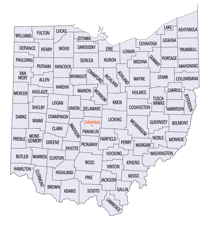Ohio Counties
There is eighty-eight counties in the state of Ohio. Washington County the oldest in the state established on July 27, 1788. Noble County was formed on March 11, 1851 from portions of Guernsey, Morgan, Monroe and Washington counties. It was the last county to be formed in Ohio and, therefore, represents the youngest county in the state.Franklin County, Ohio
Franklin County Education, Geography, and History
Franklin County is a county in the state of Ohio. Based on the 2010 census, the population was 1,163,414, making it the second-most
populous county in Ohio. Its county seat is Columbus, the state capital and most populous city in Ohio. The county was established on April
30, 1803, less than two months after Ohio became a state, and was named after Benjamin Franklin. Franklin County originally extended all the
way north to Lake Erie before Ohio subdivided further into more counties.
Franklin County is included in the Columbus, OH Metropolitan Statistical Area.
Etymology - Origin of Franklin County Name
The county was named in honor of Benjamin Franklin.
Demographics:
County QuickFacts: CensusBureau Quick Facts
Franklin County History
On March 30, 1803, the State of Ohio authorized the creation of Franklin County. The county originally was part of Ross County. The county was named in honor of Benjamin Franklin. In 1812, Columbus became Ohio's state capital. Surveyors laid out the city in 1812, and the Ohio General Assembly met
for the first time in the new capital in 1816. The first capital of Ohio was in Chillicothe and it later was moved to Zanesville and back to Chillicothe. Columbus was chosen as the site for the new capital because of its central location. The legislature selected it as Ohio's capital over a number
of other competitors, including Franklinton, Dublin, Worthington, and Delaware.
Prior to the state legislature's decision in 1812, Columbus did not exist. The city was designed and platted to be the state's capital. The first state penitentiary was completed in 1813. The first church, school, and newspaper as well as the new statehouse were opened in 1814. The new capital had a
population of seven hundred people by 1815. Columbus officially became the county seat in 1824. In 1834 the population of Columbus was five thousand people and the capital officially became a city.
Columbus is currently the largest city in population in Ohio. Columbus's population was 711,470 people in 2000, while Franklin County had 1,068,978 residents. The county's population had increased by more than eleven percent between 1990 and 2000. Franklin County's 540 square miles averaged 1,980
people per square mile in 2000. Despite this dense population, Franklin County still had six hundred farms, averaging 170 acres apiece, in 2000.
The largest employers in Franklin County are service industries with sales establishments finishing a relatively close second. Government and manufacturing positions finish third and fourth respectively. Franklin County has changed through the twentieth century as the economy of the United States
has changed as well. Nationwide Insurance, The Limited, Cardinal Health and other major businesses now employ the county's residents. Columbus is the birthplace of Wendy's International, Inc. and the longtime home of White Castle System, Inc.
A number of major educational institutions are located in Franklin County. They include Capital University, Columbus State Community College, Franklin University and Ohio Dominican University. The largest of these institutions is The Ohio State University. Major research service organizations such
the Battelle Memorial Institute, OCLC Online Computer Library Center, Inc., and Chemical Abstracts Service are also based in Franklin County.
Franklin County also has a strong cultural life with a large number of music, drama, dance and other arts organizations. The Columbus Museum of Art, the Ohio Historical Center, and the Center for Ohio Science and Industry are three of the county's important museums. Franklin County was the home of
the 2002 NCAA football national champion Ohio State Buckeyes. The Columbus Blue Jackets, a member of the National Hockey League, and the Columbus Crew, a professional soccer team, are also located in the capital city.
Most voters in Franklin County claim to be independents. Among Franklin County's more prominent residents were a number of national, state and local political figures who either came from Columbus or stayed here to live after their terms in office. American artists George Bellows and Alice Schille
were Columbus natives as was Eddie Rickenbacker, America's World War I Ace of Aces. The home of Columbus humorist James Thurber has been restored as a museum and literary center.
Sources
Franklin County, Ohio History Central, July 23, 2008,
http://www.ohiohistorycentral.org/entry.php?rec=1928&nm=Franklin-County
Geography: Land and Water
As reported by the Census Bureau, the county has a total area of 544 square miles (1,410 km2), of which 532 square miles (1,380 km2) is
land and 11 square miles (28 km2) (2.1%) is water. The county is located in the Till Plains and the Appalachian Plateau land regions.
The county is drained by the Olentangy River and the Scioto River. Major creeks in the county include Big Darby Creek, Big Walnut Creek, and
Alum Creek. There are two large reservoirs in the county, Hoover Reservoir and Griggs Reservoir.
Neighboring Counties
Bordering counties are as follows:
- Delaware County (north)
- Licking County (northeast)
- Fairfield County (southeast)
- Pickaway County (south)
- Madison County (west)
- Union County (northwest)
Education







